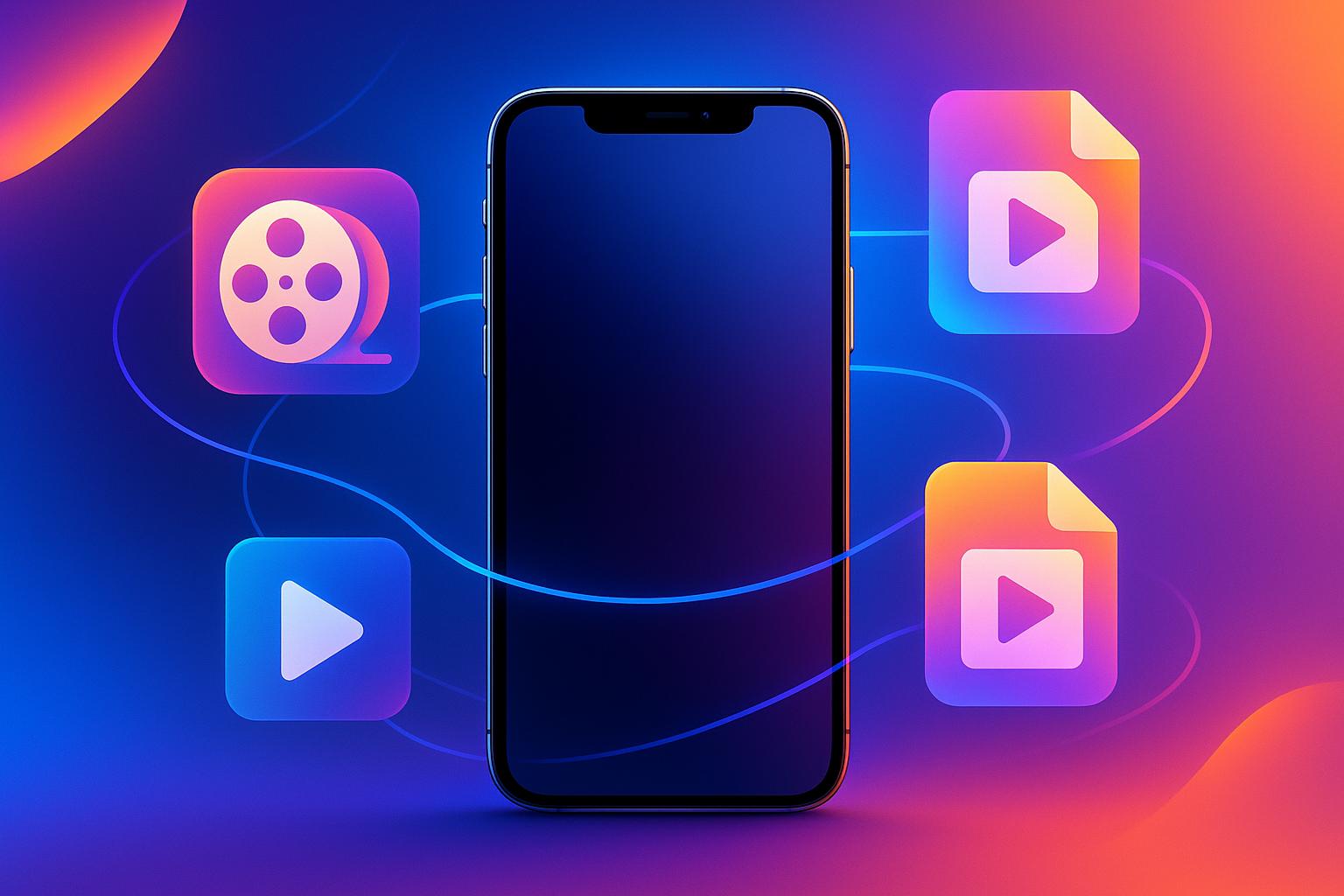Generative Compression for Video: What to Know


Generative Compression for Video: What to Know
Generative compression is reshaping how videos are processed by using AI to deliver smaller file sizes without sacrificing quality. Unlike older methods like H.264 or HEVC, which rely on removing redundant data, generative models reconstruct video frames intelligently, focusing on key details like faces and text. This approach allows for better performance, especially in low-bitrate scenarios such as streaming or video calls.
Key Points:
- Why It Matters: Rising demand for high-resolution formats (4K, 8K) and increased video consumption strain bandwidth and storage systems.
- How It Works: AI models (e.g., GANs, CNNs) analyze spatial and temporal data to prioritize important details while compressing less critical areas.
- Challenges: High computational needs, inconsistent quality with abstract visuals, and lack of standardization hinder broader adoption.
- Applications: Useful for streaming, video calls, and media management by improving quality in bandwidth-limited environments.
Generative compression is already making strides in industries like streaming and communication, but its adoption depends on overcoming technical and cost-related barriers.
First AI Codec Running in FFmpeg & VLC – Deep Render’s Breakthrough
How Generative Compression Works
Generative compression uses deep learning to reconstruct video frames instead of simply discarding redundant data. This method achieves high compression rates while preserving, and often improving, visual quality compared to traditional techniques.
What Are Generative Models?
Generative models are a type of AI that learns patterns from data and uses that knowledge to create new content. In video compression, tools like generative adversarial networks (GANs) and convolutional neural networks (CNNs) are key players. GANs operate with two networks: a generator that produces compressed data and a discriminator that evaluates how realistic the output is. On the other hand, CNNs specialize in identifying spatial details, which helps retain critical visual elements. By understanding the semantic structure of a scene, these models can focus on essential components like faces, objects, or text, ensuring better visual fidelity.
Leveraging Spatial and Temporal Data Patterns
Generative models excel by analyzing both spatial and temporal patterns in video data. Unlike traditional methods that rely on pixel-by-pixel predictions, these models recognize complex relationships across entire sequences. This allows them to maintain consistent features even when lighting changes or objects move. This capability is especially important in low-bitrate conditions, where clarity is harder to achieve.
Smart Reconstruction and Priority-Based Compression
One of the standout features of generative compression is its ability to prioritize key elements in a frame. Rather than treating all parts of a frame equally, the system focuses on semantically important areas - like faces and text - while reducing emphasis on less critical background details. A great example of this approach is the Pleno-Generation (PGen) framework, introduced in February 2025 by Bolin Chen, Hanwei Zhu, and their team. This framework showcased a scalable way to compress face videos by encoding facial details at varying granularities, such as 8x8, 16x16, and 32x32 pixel blocks. This adaptability ensures realistic visuals while adjusting to bandwidth constraints.
The process begins by encoding essential data into a base layer that captures the foundational structure of each frame. If bandwidth allows, additional enhancement layers - powered by attention-based GAN models - add finer details. A coarse-to-fine strategy then refines the visuals further by integrating textures and intricate details. Together, these techniques enable generative compression to deliver impressive visual quality, even at bitrates where traditional methods struggle [1]. This makes it an excellent choice for applications like streaming and live communication, where maintaining clarity is crucial.
Pros and Cons of Generative Compression
Generative compression offers a modern solution to some of the limitations seen in traditional compression methods. It focuses on preserving essential details even at lower bitrates, all while achieving significant reductions in file size.
Main Benefits
Generative compression stands out by maintaining and even improving key details in videos, especially at lower bitrates. Instead of uniformly degrading quality, it prioritizes critical elements like textures and details that viewers are most likely to notice.
This approach dynamically adjusts to bandwidth conditions and highlights key visual elements, such as faces and text. As a result, it delivers better quality in scenarios like streaming, storage, and mobile data use. This adaptability is especially helpful in environments with fluctuating network speeds or limited storage capacity. However, these advantages come with technical and practical challenges that cannot be overlooked.
Technical Challenges
Despite its benefits, generative compression introduces several hurdles that complicate its widespread adoption. One of the biggest challenges is its high computational demand. The deep learning models required for encoding and decoding rely heavily on advanced processing power, often necessitating specialized GPUs or AI-specific hardware. This dependency not only increases costs but also adds complexity to implementation.
Another issue is inconsistency in quality across different types of content. Generative models excel with videos that feature familiar objects like faces, but they struggle with abstract visuals, rapid motion, or intricate textures. This variability makes it difficult to ensure consistent performance for all types of content.
Additionally, the lack of universally accepted standards for generative compression creates compatibility problems. Unlike traditional codecs, which are widely supported across devices, generative methods face deployment issues. The intensive processing required by neural networks also introduces latency, making real-time applications like live streaming or video conferencing more challenging unless specialized acceleration hardware is used.
Generative vs Standard Compression Methods
Aspect | Generative Compression | Standard Compression (H.264/H.265) |
|---|---|---|
Compression Ratio | Achieves greater file size reduction while preserving quality | Moderate size reduction, often at the expense of quality |
Visual Quality | Focuses on enhancing key details and semantic elements | Uniform degradation under heavy compression |
Hardware Requirements | Requires advanced GPUs or AI-specific hardware | Works efficiently on standard processors |
Processing Speed | Slower due to complex computations | Optimized for fast, real-time encoding/decoding |
Content Adaptability | Performs well with recognizable objects but struggles with abstract scenes | Delivers consistent results across varied content |
Industry Support | Limited standardization and compatibility | Broad device compatibility and industry support |
Power Consumption | Higher energy usage due to intensive processing | Lower power consumption with optimized methods |
Implementation Cost | Higher costs due to reliance on specialized hardware | More affordable with established technologies |
Where Generative Compression Is Used
Generative compression, despite its technical hurdles, is already finding its way into several industries. Its ability to deliver quality at low bitrates makes it particularly useful in scenarios where bandwidth and storage are limited.
Video Streaming and Bandwidth Savings
The streaming industry is one of the most promising areas for generative compression. Streaming services constantly strive to deliver high-quality content while managing bandwidth demands and ensuring smooth playback.
Generative compression shines in ultra-low bitrate streaming, making it a game-changer for mobile users with limited data plans. Even when bandwidth drops to levels that would typically result in poor playback, this technology can maintain acceptable visual quality. Thanks to its smart reconstruction capabilities, viewers can avoid the usual blocky artifacts or severe quality dips during network fluctuations.
This technology is especially valuable in rural areas with limited internet infrastructure. Where traditional high-definition streaming might be out of reach, generative compression can step in by reconstructing key visual details rather than transmitting every pixel.
Another standout feature is content-aware optimization. For videos with recognizable elements like faces or text, generative models can allocate more resources to preserve these critical details while compressing less important background elements. This makes it particularly effective for real-time video communications.
Video Calls and Live Communication
Generative compression also addresses the unique challenges of real-time communication. Video calls must juggle quality, latency, and bandwidth while adapting to ever-changing network conditions.
For video calls over unstable or slow internet connections, generative compression ensures that facial clarity and expression recognition remain intact, even when bitrates drop significantly. This focus on preserving human features makes conversations feel more natural, allowing participants to read facial expressions and maintain eye contact despite poor network performance.
In professional video conferencing, the technology proves especially useful. It prioritizes semantically important details like speaker faces, on-screen text, and presentation slides, ensuring these elements remain clear. Meanwhile, static backgrounds can be more heavily compressed without disrupting the meeting experience.
While generative compression demands high computational power, which can lead to latency without specialized hardware, its potential extends beyond streaming and video calls into media management applications.
Working with Media Management Tools
Generative compression is also poised to enhance media management by addressing bandwidth and storage challenges. Applications that handle large video libraries, transfer media files, or stream content between devices can leverage this technology to improve efficiency.
For instance, tools like Softorino’s WALTR PRO and Beamer 4 could reduce transfer times and enable smoother streaming on devices with limited bandwidth. Smaller file sizes achieved through generative compression mean faster transfers and more storage space on devices.
The content-aware nature of generative compression aligns perfectly with media management workflows. Videos with important details - like tutorials, presentations, or cherished family moments - can be prioritized to ensure key elements remain sharp after compression.
Media management tools could also incorporate intelligent batch processing. By analyzing entire video libraries, generative compression could apply tailored strategies for different content types, optimizing family videos differently from screen recordings or downloaded media.
While hardware demands and processing complexity currently limit widespread use in consumer tools, advancements in AI acceleration are likely to make these applications more accessible for everyday users managing their digital media collections.
What’s Next for Generative Compression
Generative compression is steadily advancing, aiming to overcome its current limitations and seamlessly integrate into everyday tools. As this technology matures, it’s likely to become more accessible and embedded into standard applications.
Current Research Focus Areas
To tackle the challenges of traditional methods, researchers are zeroing in on issues like error propagation, computational efficiency, and perceptual quality. These efforts include creating error-resilient architectures, refining lightweight models, and developing new evaluation methods to replace outdated metrics like PSNR.
One major hurdle is error propagation, where decoding mistakes can snowball into larger issues. To address this, researchers are exploring architectures capable of detecting and correcting errors before they escalate. Some teams are even testing hybrid models that blend traditional compression techniques with generative methods, using conventional approaches as a fallback when generative systems struggle.
Efficiency is another area of focus. Lightweight model architectures are being designed to handle real-time applications, and hardware-accelerated solutions are being developed to make generative compression more practical for everyday use.
Another key challenge is measuring perceptual quality. Traditional metrics like PSNR often fail to account for how good the output looks to the human eye. Generative compression might produce visually appealing results but score poorly on these outdated metrics. To bridge this gap, researchers are creating new evaluation methods that better align with human perception, ensuring the technology’s performance is judged more accurately.
These advancements lay the groundwork for generative compression to transition from research labs to practical use in both consumer and professional settings.
Adding to Consumer and Professional Software
As hardware gets more powerful and processing costs drop, generative compression is poised to become a staple in mainstream software. It could prove especially useful in media management tools where users frequently handle large video files.
Take tools like Softorino’s WALTR PRO and Beamer 4, for example. By incorporating generative compression, these applications could significantly reduce transfer times and enhance streaming performance. WALTR PRO users transferring large video libraries to iOS devices might experience much faster transfers, while Beamer 4 users streaming to Apple TV could enjoy smoother playback even on slower networks.
Generative compression could also tailor compression to specific needs. Family videos, for instance, could prioritize faces and key moments, while screen recordings could focus on preserving text clarity and interface details.
Professional video editing software is another area ripe for adoption. Generative compression could streamline proxy workflows, allowing editors to work with highly compressed preview files that retain crucial visual details. When exporting final versions, the same compression settings could be applied to meet bandwidth or storage limits without compromising quality.
The rise of on-device AI acceleration on smartphones and tablets also opens up new possibilities. Generative compression could be used for video calls, social media uploads, and cloud storage synchronization, automatically adjusting settings based on available bandwidth and storage space. As hardware continues to evolve, this technology could become a standard feature in mobile devices, making media management more efficient.
The Promise of Generative Compression
Generative compression takes a fresh approach to video processing by focusing on the most critical content instead of treating all pixels equally.
The potential for bandwidth savings is especially appealing in today’s hyper-connected world. With video content dominating internet traffic, generative compression could enable streaming platforms to deliver better quality at lower costs. It could also make high-definition content more accessible in areas with limited internet infrastructure.
By optimizing bandwidth and storage without sacrificing quality, this technology promises smoother streaming, faster file transfers, and better real-time communication. Features like automatic content optimization could eliminate the need for users to manually tweak compression settings, making the process effortless.
What’s exciting is that generative compression can integrate seamlessly into existing workflows without requiring users to learn new tools or change their habits. It could quietly work in the background, improving video quality and reducing file sizes without any extra effort from the user.
As research continues to refine the technology and hardware capabilities improve, generative compression is on track to become a standard feature in video applications. Its ability to balance quality and efficiency makes it an appealing solution for developers and users alike, addressing the growing demands of video content in a rapidly evolving digital landscape.
FAQs
What makes generative video compression different from traditional methods like H.264 or HEVC?
Generative video compression leverages deep learning models, such as generative adversarial networks (GANs), to reconstruct high-quality video from significantly compressed data. These models excel at identifying patterns and generating realistic details, producing visually impressive results even when working with extremely low bitrates.
On the other hand, traditional codecs like H.264 or HEVC depend on fixed algorithms for tasks like motion estimation, quantization, and entropy coding. Generative techniques stand out by achieving higher compression ratios through synthesizing missing details based on learned data models. This makes them a more efficient and visually appealing option for video compression.
What challenges might arise when using generative compression for real-time video applications like video calls?
Generative compression for real-time video applications, like video calls, comes with its own set of hurdles. A major concern is keeping latency low to ensure conversations remain fluid. Even small delays in processing can throw off the natural rhythm of communication, making the experience frustrating.
On top of that, generative models require a lot of computational power, which can push hardware to its limits. This makes real-time use a tough challenge to tackle. To bring generative compression into everyday use for real-time applications, there’s a strong need to improve AI efficiency and boost processing capabilities.
How does generative compression enhance video quality in low-bandwidth situations, and what does it mean for the future of video streaming?
Generative compression leverages advanced AI models, like generative adversarial networks (GANs), to enhance video quality in low-bandwidth scenarios. By recreating high-quality visuals with less data, it ensures video streams remain clear and detailed, even when network capacity is limited.
In the future, AI-driven generative codecs are set to reshape video streaming. These technologies could reduce file sizes by as much as 30–50% without sacrificing quality. The result? More efficient data transmission, smoother live streams, and an improved viewing experience - particularly in situations where bandwidth is tight.



